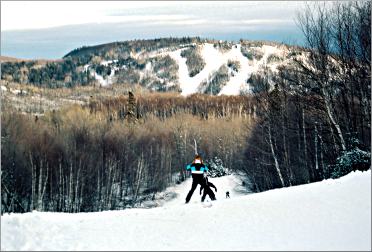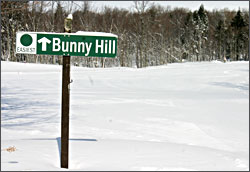Classroom on the slopes
Alpine skiing is more fun when you learn how to do it better.

© Beth Gauper
When you live in the frozen north, you may as well embrace winter.
My idea of fun is to cross-country ski, but for that, Mother Nature needs to bring snow. But alpine skiing, which I also like, requires only some big snow guns.
After one wimpy winter, I bought alpine skis. They cost a lot, but I can actually use them, unlike my Nordic skis, all winter long.
After another wimpy winter, I decided I might be using them a lot. So I called the ski school at Lutsen Mountains, on Minnesota's North Shore, and asked instructor Marcela Perez-Abreu how I could get over the "intermediate hump."
"That's a tough plateau to break," she said. "But you're going to break it a lot easier and faster with some instruction."
That's how I ended up sitting on a Lutsen chairlift with Arnie Wright, who was a ski instructor on loan from Cascade Mountain in Wisconsin, discussing black-diamond runs.
So far, I could only ski them ugly: crouching, making wide turns, wedging to slow down.
But how could I be like other skiers I'd seen, making those tidy little turns, knees together, swish-swish-swish down a sheer drop? How could I look cool?
Wright, who spends every March skiing at Vail, sighed and thought about it.
"Lots of practice," he finally said. "The average Midwesterner is lucky to ski 10 or 15 days a year, okay? People who get very good ski a lot more."
I knew to push my shins against the tops of my boots and to pull my butt in rather than sit back as if water-skiing. I knew not to turn with my shoulders, and to keep my upper body pointed downhill.
But tidily carved turns? Hardly.

© Beth Gauper
The key, Wright said, is the little toe. Roll the little toe left to turn left, and right to turn right; the other leg will follow. Tip, and then tip some more.
If you do it right, you'll see two pencil-thin arcs carved in the snow behind you.
Near the top of an easy run, we did exercises, carving figure-eights with boots only, then one ski, then two.
We did them in garlands, putting our weight on one ski and swishing the other one in and out. We practiced briefly releasing edges before quickly tipping into the next turn.
"Carving turns is a blast," Wright said. "When skis hook up with snow, it's really, really fun."
A wicked wind was blasting away at Eagle Mountain, slowing skiers in the middle of Bridge Run, and the snow was icy; Wright called it "sugar," but it was more like kosher salt.
It lay in loose piles on the narrow Catwalk, where I caught an edge and crashed — a "learning experience," my instructor said.
Watching me, he told me to maintain balance by rolling my pelvis slightly forward and keeping my arms in front of me, and he demonstrated by wedging his poles horizontally between his chest and elbows, hands sticking straight out.
I tried it, and it worked.
At the end of the hour, he took me past the "Experts Only" banner to the black-diamond Koo-Koo and I followed him down, too focused to be afraid.
The next day, I took another lesson, and a 13-year-old from Lakeville joined us.
We did some more figure eights and practiced the same techniques as the day before — but then he took us to a double-black diamond, the Cliff Run.

© Beth Gauper
He took off, and there was nothing to do but follow him. It was steep, it was icy, and there was a pack of wild snowboarders crunching down behind us. But we suspended fear — all thought, in fact — and did it.
It was a Cowardly Lion moment, since my "courage" consisted mainly of Wright's assurance that I could do it. Still, I'm now officially a double-black diamond skier. The next trick will be to make it look easy.
Trip Tips: Where to ski and take lessons
All ski hills offers lessons, and many offer great deals for beginners. They don't publicize them much, so you have to ask.
For more, see Bargains for beginners.
Always check websites for deals and packages. Buy online and in advance to save money. Reserve lessons and children's programs in advance.
Late winter and spring is a good time to learn, when snow is softer and more forgiving.
For a guide to ski areas in the Upper Midwest, see Fun in the fast lane.